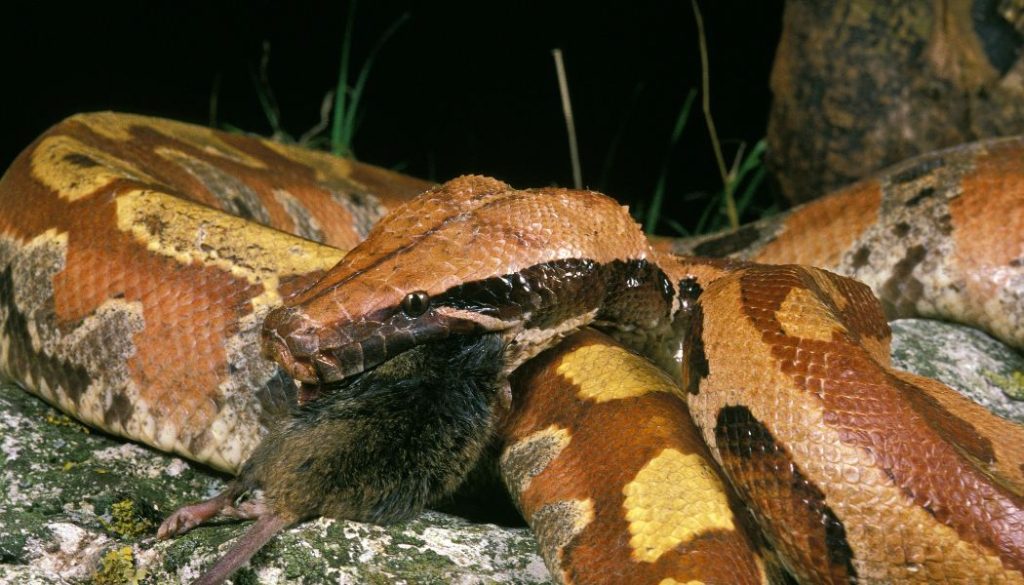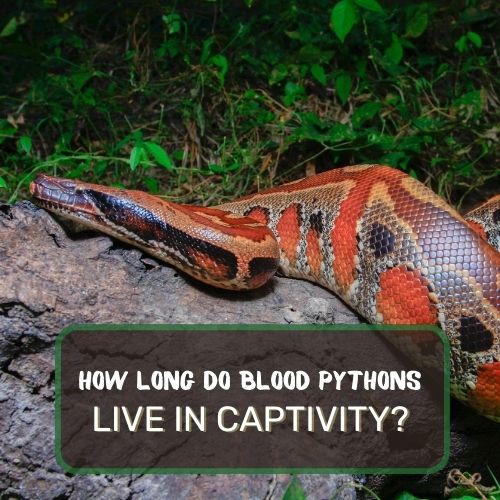Welcome to a journey into the nocturnal world of blood pythons! In this article, we’ll uncover the intriguing behaviors and needs of these fascinating reptiles. We delve into their unique activity patterns, examining whether they truly are creatures of the night.
Yes, blood pythons are primarily nocturnal. They are most active at night, hunting and exploring in the darkness. This nocturnal behavior aligns with their natural instincts and adaptations for survival in their native habitats.
From understanding the nuances of nocturnal versus crepuscular lifestyles to their specific lighting, housing, and care requirements in captivity, we explore every angle.
Plus, we answer some of the most commonly asked questions about blood pythons.
Join us as we shed light on the mysterious life of these remarkable snakes, providing insights for both curious minds and potential snake owners.

Table of Contents
Understanding Nocturnality in Snakes
When we think about snakes, images of these slithery creatures basking in the sun might pop into our heads. But, let’s flip the switch and explore the dark, mysterious world of nocturnal snakes. To really get a grip on whether blood pythons are night owls, it’s crucial to first understand what being nocturnal means in the serpentine world.
Nocturnality in snakes isn’t just about shunning the daylight for moonlit escapades. It’s a sophisticated adaptation to the environment, predator avoidance, and prey availability.
Nighttime offers cooler temperatures, which is a big deal for these cold-blooded animals. Imagine wearing a fur coat in the desert – not so comfortable, right? That’s how it is for many snakes in the heat of the day.
Moreover, the cover of darkness provides a stealth advantage. It’s like playing hide and seek, but with higher stakes – survival and dinner! For snakes that prefer dining under the stars, it means they can sneak up on unsuspecting prey or avoid becoming a meal themselves.
So, when we dive into the world of blood pythons, it’s this nocturnal playbook we need to keep in mind. Are they the night-loving type or day-trippers? Let’s find out next.
Blood Python’s Nocturnal Behavior
Ah, the blood python, a snake that sounds like it stepped right out of a spooky story. But beyond its dramatic name lies a fascinating question: Are these creatures creatures of the night? Let’s unravel this mystery.
First off, blood pythons are not your average backyard snake. Hailing from the lush rainforests and swamps of Southeast Asia, they’re quite the exotic bunch. Their lifestyle revolves around a schedule that might seem alien to us day-dwellers. While we’re tucking into bed, these pythons are just starting their day… or should we say night?
Here’s the deal: blood pythons are primarily nocturnal. When the sun sets, these serpents come alive. It’s their time to hunt, explore, and do all things snake-y. Think about it as their ‘night shift’.
During the day, they’re more about lounging and digesting, hidden away from the prying eyes of predators and the scorching sun.
Their nocturnal nature is a well-crafted survival strategy. Blood pythons, with their heavy, muscular bodies, aren’t the sprinters of the snake world. They rely on ambush tactics – lying in wait for an unsuspecting meal to wander by. Nighttime provides the perfect cloak for this stealthy approach.
But it’s not just about hiding and seeking. Being active at night helps these pythons regulate their body temperature. The cool night air is a relief from the tropical daytime heat. Plus, the darkness reduces the risk of dehydration – a real concern for these moisture-loving reptiles.
In captivity, this nocturnal rhythm continues. Blood python owners often notice their pets becoming more active as evening approaches. It’s a little reminder of their wild, nocturnal roots – a trait that makes them intriguing yet a bit challenging for snake enthusiasts.
Crepuscular vs. Nocturnal – Understanding Blood Python Activity
Navigating the twilight zone of snake behavior, we often stumble upon two intriguing terms: nocturnal and crepuscular. With blood pythons, it’s like a game of shadowy semantics. These creatures are often labeled as nocturnal, but guess what? They have a bit of a crepuscular streak too.
Crepuscular creatures are the twilight aficionados. They are most active during the soft glow of dawn and dusk. Think of it as catching the early bird special or enjoying a late-night snack.
Blood pythons? They straddle this line a bit. While they love the nightlife, they are also known to be up and about at dusk or dawn. It’s their way of maximizing efficiency – cooler temperatures, less competition, and a buffet of prey that’s active during these times.
This adaptation is a brilliant strategy in the wild. Blood pythons, with their impressive girth and slower movement, benefit from the low-light conditions of dawn and dusk. It gives them the element of surprise, crucial for their hunting technique.
So, while we often peg them as nocturnal, these snakes are quite the opportunists, adapting their activity to the most advantageous times of day.
Lighting Needs for Blood Pythons
When it comes to setting up a cozy home for a blood python, lighting plays a starring role. Remember, these are snakes that are used to the rhythms of day and night in the wild. Mimicking this in captivity is key to keeping them healthy and happy.
First things first: blood pythons are not sunbathers. Unlike some of their reptilian cousins who love to soak up rays, blood pythons are more about the low-key light life.
In their natural habitat, they spend much of their time hidden away, emerging primarily at night. This means that, in captivity, they don’t require intense basking lights like some other reptile species.
However, a gentle light cycle is still important. Providing a day-night rhythm helps regulate their biological clock. Think of it as setting the mood. During the day, a soft, ambient light works wonders.
It shouldn’t be too bright or produce a lot of heat. Remember, we’re trying to mimic the dappled sunlight of a forest floor, not a beach at midday.
As for the night-time, it’s all about darkness. This is when blood pythons come into their own. Keeping their enclosure dark at night aligns with their natural nocturnal instincts. It’s their time to ‘wake up’ and explore.
So, when setting up their enclosure, consider a light source that can be easily controlled or put on a timer. This way, you can replicate the natural cycle of day and night, giving your blood python a little slice of the wild, right in your home.
Housing and Care in Captivity
Creating a comfortable abode for a blood python in captivity is like setting the stage for a nocturnal symphony. These snakes thrive in environments that mimic their natural habitats.
A spacious enclosure is key, ideally one that allows for both hiding and ample room to stretch. Picture a cozy den with enough space to roam – that’s the dream home for a blood python.
The substrate should be a priority, offering both comfort and utility. Materials like cypress mulch or coconut fiber work well, providing a natural feel and helping maintain humidity.
Speaking of humidity, it’s crucial to keep the levels in check, hovering around 60-70%. This mimics the damp, swampy environments they’re accustomed to.
Temperature gradients are essential too. Warm on one end (around 85 degrees Fahrenheit) and cooler on the other, allowing the python to regulate its body temperature.
This setup, combined with a consistent day-night light cycle, creates a mini ecosystem for your nocturnal companion, ensuring they feel right at home.
Interaction and Handling Related to Their Nocturnal Behavior
Interacting with a blood python requires a gentle touch and an understanding of their nocturnal nature. These snakes, active primarily at night, might not be the early birds of the reptile world, but with the right approach, they can be engaging pets. It’s all about timing and respect for their unique rhythm.
Handling should ideally coincide with their active periods. Late afternoons or evenings are when they’re more receptive and alert. This aligns with their natural cycle, making the interaction more comfortable for them.
It’s important to be gentle and calm, allowing the python to become accustomed to your presence. Quick, sudden movements can startle them, especially during their less active daytime hours.
Remember, blood pythons, though generally placid, can be unpredictable. Regular, but not excessive, handling helps build trust. It’s like building a friendship; it takes time and patience, especially considering their nocturnal tendencies.
With consistent and respectful interaction, a blood python can become a fascinating and enjoyable companion, offering a glimpse into the mysterious nocturnal world of snakes.
Final Word
You’ve just journeyed through the nocturnal realm of blood pythons, exploring their unique behaviors and needs.
Understanding these captivating creatures enhances our appreciation for their distinct lifestyle, from their evening activities to their specific care in captivity.
As you reflect on these insights, remember that your interest and understanding can significantly contribute to the well-being and conservation of these remarkable snakes.
Keep exploring and learning – every bit of knowledge brings us closer to the fascinating world of these nocturnal wonders!
FAQ
Are blood pythons active?
Blood pythons are indeed active, but their activity peaks during the night. Their nocturnal nature means they’re more lively and responsive after dusk, aligning with their natural predatory instincts. During the day, they tend to be more sedentary, often spending time resting or digesting their food. Understanding this pattern is crucial for owners who want to interact with their pet at the right times.
Do blood pythons need light?
While blood pythons don’t require intense lighting like some reptiles, a moderate light setup is beneficial for maintaining a natural day-night cycle. Ambient lighting during the day, mimicking the soft, filtered light of their natural habitat, helps regulate their biological clock. However, it’s important to ensure their enclosure is dark at night to align with their nocturnal habits.
What is the behavior of a blood python?
Blood pythons are known for their calm demeanor, but they can be unpredictable at times. They are ambush predators, preferring to wait for prey rather than actively hunt. In captivity, they often exhibit a relaxed nature but can become stressed if mishandled or exposed to excessive activity during their rest periods. Understanding their need for tranquility, especially during daylight hours, is key to their care.
Can pythons see in the dark?
Pythons, including blood pythons, have adapted to see in low-light conditions. They may not have perfect night vision like some nocturnal animals, but they can navigate and hunt effectively in the dark. Their senses of smell and heat detection also play significant roles in locating prey at night.
Do blood pythons need a hide?
Absolutely! Providing a hide is essential for the well-being of a blood python. It offers them a sense of security and a place to retreat, especially during the day when they’re less active. Hides mimic the secluded spaces they would seek in the wild and help reduce stress, making them a crucial element of the enclosure setup.




0 Comments